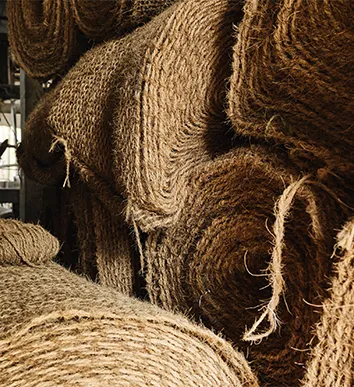La star des mers du Sud, une éternelle globe-trotteuse

La reine des fruits surplombe le décor. À plus de vingt mètres du sol, la noix de coco se balance par les chaudes journées d’été, recouverte de feuilles de cocotier, qui la protègent telles de puissantes ailes.
Sa Majesté a choisi un endroit sublime. Depuis son emplacement privilégié, elle voit les lagons, la mer, les marais et même la jungle. Un vent chaud souffle à travers les cimes. Un bruissement, le doux son des tropiques.
Suspendue, elle mûrit sereinement et devient plus charnue, plus ronde et plus juteuse. La reine des mers du Sud a bien mérité de trôner au septième ciel, en surplomb des plages de sable blanc entre les Caraïbes et la Polynésie.
Mangues, papayes et fruits de la passion ne font pas le poids face à la reine des reines. Ils ne sont que de simples petits fruits sucrés poussant sur un arbuste quelconque. Et que dire de la banane, cette chose tordue qui ne pèse que 150 g et qui pourrit en un clin d’œil.
Tout le contraire de la reine, qui peut peser trois kilos au meilleur de sa forme et reste ultrafraîche, même après un tour du monde en mer. Non, la noix de coco ne se laisse pas impressionner aussi facilement. Elle est la star des mers du Sud, l’incarnation de toutes les robinsonnades. Laissez-nous vous présenter le cocos nucifera, véritable icône parmi tous les arbres tropicaux.
La reine des fruits surplombe le décor. À plus de vingt mètres du sol, la noix de coco se balance par les chaudes journées d’été, recouverte de feuilles de cocotier, qui la protègent telles de puissantes ailes.
Sa Majesté a choisi un endroit sublime. Depuis son emplacement privilégié, elle voit les lagons, la mer, les marais et même la jungle. Un vent chaud souffle à travers les cimes. Un bruissement, le doux son des tropiques.
Suspendue, elle mûrit sereinement et devient plus charnue, plus ronde et plus juteuse. La reine des mers du Sud a bien mérité de trôner au septième ciel, en surplomb des plages de sable blanc entre les Caraïbes et la Polynésie.
Mangues, papayes et fruits de la passion ne font pas le poids face à la reine des reines. Ils ne sont que de simples petits fruits sucrés poussant sur un arbuste quelconque. Et que dire de la banane, cette chose tordue qui ne pèse que 150 g et qui pourrit en un clin d’œil.
Tout le contraire de la reine, qui peut peser trois kilos au meilleur de sa forme et reste ultrafraîche, même après un tour du monde en mer. Non, la noix de coco ne se laisse pas impressionner aussi facilement. Elle est la star des mers du Sud, l’incarnation de toutes les robinsonnades. Laissez-nous vous présenter le cocos nucifera, véritable icône parmi tous les arbres tropicaux.
La noix de coco mérite aussi une attention particulière pour une tout autre raison : elle voyage depuis bien avant l’existence des humains. Véritable aventurière aguerrie, elle est le prototype même d’une globe-trotteuse.
Les cocotiers sauvages existent depuis 70 millions d’années. Les premiers ont probablement poussé en Nouvelle-Zélande, en Australie ou encore en Colombie. Leurs fruits audacieux ont rapidement voulu explorer le monde. C’est pourquoi un jour ils décidèrent de se laisser tomber dans le sable, de rouler dans les vagues et de dériver au gré des flots : à travers les sept mers jusqu’aux côtes lointaines de l’Indonésie et aux îles coralliennes inexplorées des océans lointains.




Pendant des mois, les fruits à coque ont dérivé en pleine mer. Les noix de coco peuvent parcourir des milliers de milles nautiques et germer même après plusieurs mois passés dans l’eau salée. Il leur suffit de s’échouer quelque part pour donner naissance à de nouveaux cocotiers. C’est ainsi que la reine a conquis le monde et s’est installée principalement sous des latitudes tropicales, dans les régions équatoriales qui nous font encore aujourd’hui rêver lorsque nous sommes pris d’une irrésistible envie de voyager. Plages de sable blanc paradisiaques, lagons bordés de cocotiers. C’est dans ce décor de rêve que la noix de coco règne en maître. La plus irrésistible de toutes les tentations tropicales.
Peu après six heures du matin, le soleil se lève sur le sud de l’Inde. La côte du Kerala (Malabar) se réveille et des corbeaux tournoient au-dessus de la ville portuaire de Kochi, située au bord de la mer d’Arabie. Les cocotiers poussent partout et recouvrent la moitié du pays. L’état indien de la côte de Malabar porte d’ailleurs le nom de la reine, Kerala, qui signifie « pays des cocotiers ». Et Kochi est connue comme étant la capitale mondiale de la noix de coco.
Ici, ces fruits verts sont vendus à presque tous les coins de rue. Rares sont les étals de plage où les Indiens ne sirotent pas leur eau de coco tant appréciée. L’Inde sans noix de coco, impossible ! C’est comme si on retirait la pomme de terre aux Allemands, les tulipes aux Hollandais ou encore les cheeseburgers aux Américains.
Mais la noix de coco est cosmopolite et convoitée dans le monde entier. De Tahiti à Hawaï en passant par les baies turquoise entre Bali et la Barbade et les plages entre Sumbawa et Zanzibar. Elle règne sous les latitudes tropicales. Rien d’étonnant que le cocos nucifera fasse tourner autant de têtes.
Les affiches des premiers paquebots arboraient déjà des motifs de cocotiers majestueux. Ce grand arbre tropical portant des noix de coco bien rondes était déjà à l’époque un motif publicitaire très apprécié. En 1931 une boisson appelée Afri-Cola fut lancée sur le marché et en 1951, une célèbre barre chocolatée portant le nom de Bounty vit le jour. Bouteilles et emballages étaient décorés de cocotiers et de noix de coco. Aujourd’hui encore, ce motif prometteur est largement utilisé dans le secteur de la publicité. Compagnies aériennes, shorts de surf, voitures, hôtels, sous-vêtements, dentifrices, shampoings, glaces, rhums et rasoirs : il n’existe guère de produits au monde pour lesquels ce motif publicitaire n’a pas encore été utilisé.
Ce fruit tropical vert est omniprésent. Sans cocotier et noix de coco, les publicitaires seraient complètement perdus !

Les affiches des premiers paquebots arboraient déjà des motifs de cocotiers majestueux. Ce grand arbre tropical portant des noix de coco bien rondes était déjà à l’époque un motif publicitaire très apprécié. En 1931 une boisson appelée Afri-Cola fut lancée sur le marché et en 1951, une célèbre barre chocolatée portant le nom de Bounty vit le jour. Bouteilles et emballages étaient décorés de cocotiers et de noix de coco. Aujourd’hui encore, ce motif prometteur est largement utilisé dans le secteur de la publicité. Compagnies aériennes, shorts de surf, voitures, hôtels, sous-vêtements, dentifrices, shampoings, glaces, rhums et rasoirs : il n’existe guère de produits au monde pour lesquels ce motif publicitaire n’a pas encore été utilisé.
Ce fruit tropical vert est omniprésent. Sans cocotier et noix de coco, les publicitaires seraient complètement perdus !


Au sud de l’Inde, on se moque bien de tout cela. « Les noix de coco sont notre moyen de subsistance », explique Arathy Kumani. « Nous utilisons le fruit dans son intégralité, la chair, les fibres, le lait, l’écorce, les fleurs et les feuilles. Les cocotiers font partie de notre quotidien. »
Arathy guide les visiteurs en bateau à travers les Backwaters, un labyrinthe de lagunes et de rivières qui s’enfoncent profondément dans les zones humides du Kerala. L’air est lourd, il fait très chaud dans la jungle. Deux hommes poussent la barque à l’aide de perches en bambou. Le voyage débute en silence, dans un monde où le ciel est couvert de noix de coco.
Au sud de l’Inde, on se moque bien de tout cela. « Les noix de coco sont notre moyen de subsistance », explique Arathy Kumani. « Nous utilisons le fruit dans son intégralité, la chair, les fibres, le lait, l’écorce, les fleurs et les feuilles. Les cocotiers font partie de notre quotidien. »
Arathy guide les visiteurs en bateau à travers les Backwaters, un labyrinthe de lagunes et de rivières qui s’enfoncent profondément dans les zones humides du Kerala. L’air est lourd, il fait très chaud dans la jungle. Deux hommes poussent la barque à l’aide de perches en bambou. Le voyage débute en silence, dans un monde où le ciel est couvert de noix de coco.
Dans les villages, les traditions ancestrales perdurent. Omana Tripathi, une artisane de la noix de coco de la vieille école, est accroupie devant une hutte. Omana a 72 ans et la noix de coco fait partie intégrante de sa vie depuis 50 ans. Assise par terre, elle noue une natte de coco à mains nues. Les Indiens utilisent encore aujourd’hui des feuilles de cocotier pour couvrir les toits, tresser les murs des maisons ou fabriquer des paniers.
Ils utilisent les fibres de la coco pour fabriquer des cordes, des canapés, des sacs et des matelas. Les cocotiers et leurs célèbres fruits sont utilisés comme matières premières et matériaux de construction. La noix de coco est un ingrédient de base de la cuisine asiatique. En la pressant, on obtient un huile très prisée et de nombreux produits de beauté en contiennent. Ce fruit fait aujourd’hui partie intégrante de l’économie locale.
Mais ce n’est pas tout. Les tiges des feuilles de cocotiers sont utilisées par les enfants pour jouer au cricket et de nombreuses personnes se servent des fibres pour se brosser les dents. Ce n’est pas sans raison que le cocotier est appelé « arbre de vie » sous les tropiques. En bref, le cocos nucifera est le cocotier le plus dingue de tous les temps.



Ce fruit reste cependant difficile à récolter. En effet, malgré l’alunissage, l’IA et l’invention du réfrigérateur connecté, aucune aide mécanique n’a encore été inventée pour faciliter la récolte de la reine noix de coco tout en haut de son arbre. La force musculaire est de mise, car les humains doivent grimper au sommet par leurs propres moyens !
Dans le village côtier d’Arthunkal, Tanesh Diwakar se tient sous un cocotier de 20 mètres de haut. Tanesh, 43 ans, est un grimpeur de cocotiers. Et il a fort à faire. Rien que dans son district d’Alappuzha, on recense environ 300.000 exemplaires de cette espèce. Il monte et descend donc le long des troncs pratiquement toute l’année.
Il effectue la récolte de jusqu’à douze cocotiers par matinée. Chaque arbre peut fournir 20, voire 30 noix de coco. Tel un acrobate, il grimpe au sommet, sans filet, sans sécurité, avec sa machette accrochée à la ceinture. Son salaire est d’environ 1.000 roupies, soit 11 euros par jour. « Je n’ai encore jamais reçu de noix de coco sur la tête », dit-il. « Et je ne suis encore jamais tombé ». C’est une véritable chance, car toute perte d’équilibre en hauteur pourrait entraîner une chute de dix ou vingt mètres, ce qui aurait probablement des conséquences mortelles.
Ce fruit reste cependant difficile à récolter. En effet, malgré l’alunissage, l’IA et l’invention du réfrigérateur connecté, aucune aide mécanique n’a encore été inventée pour faciliter la récolte de la reine noix de coco tout en haut de son arbre. La force musculaire est de mise, car les humains doivent grimper au sommet par leurs propres moyens !
Dans le village côtier d’Arthunkal, Tanesh Diwakar se tient sous un cocotier de 20 mètres de haut. Tanesh, 43 ans, est un grimpeur de cocotiers. Et il a fort à faire. Rien que dans son district d’Alappuzha, on recense environ 300.000 exemplaires de cette espèce. Il monte et descend donc le long des troncs pratiquement toute l’année.
Il effectue la récolte de jusqu’à douze cocotiers par matinée. Chaque arbre peut fournir 20, voire 30 noix de coco. Tel un acrobate, il grimpe au sommet, sans filet, sans sécurité, avec sa machette accrochée à la ceinture. Son salaire est d’environ 1.000 roupies, soit 11 euros par jour. « Je n’ai encore jamais reçu de noix de coco sur la tête », dit-il. « Et je ne suis encore jamais tombé ». C’est une véritable chance, car toute perte d’équilibre en hauteur pourrait entraîner une chute de dix ou vingt mètres, ce qui aurait probablement des conséquences mortelles.
Tanesh n’est qu’une personne parmi tant d’autres à gagner sa vie grâce à la noix de coco. Dans de nombreuses régions du Kerala, des hommes se tiennent devant des rouets et des métiers à tisser en bois. Dans les usines, ils fabriquent des nattes en coco destinées aux secteurs de l’agriculture et de l’horticulture. Elles permettent de protéger les sols de l’érosion ou sont utilisées comme géotextiles et substituts de tourbe. Au final, c’est un secteur d’activité important. Plus de 60 millions de tonnes de noix de coco sont récoltées chaque année dans le monde et commercialisées sur le marché international, le lait à lui seul générant des milliards de chiffre d’affaires.
Cet arbre élancé aux magnifiques feuilles ne révèle pas immédiatement sa beauté. Il trône sereinement sous les tropiques et a un effet apaisant. Mais à l’instar d’une reine, il vaut son pesant d’or. Le Kerala dispose même d’un Conseil de développement de la noix de coco et a proclamé une « Journée mondiale de la noix de coco ».


Pour découvrir le véritable royaume de Sa Majesté, il faut cependant aller encore un peu plus loin. À plus de 500 km, au cœur de l’océan Indien, se trouve l’archipel du Lakshadweep : un ensemble de 36 îlots recouverts de cocotiers, flottant sur l’océan tels des disques blancs. Les plages, baignées de soleil, sont couvertes de sable corallien blanc, à l’ombre des cocotiers. C’est ici que réside la reine noix de coco, dans ce qui est son habitat naturel depuis des millénaires : la destination de rêve ultime au cœur de la mer de Corail.
Dans cet écosystème proche de l’équateur, la vie est simple. Récifs et requins... ici il n’y a que la mer, les poissons et les noix de coco, tout le reste doit être acheminé par bateau.
Au paradis, on marche lentement, les pieds nus dans le sable. Le soleil tape et la vie s’écoule lentement. Le soir, la lune se lève sur les îles. Les cocotiers se dressent au bord de la mer comme des silhouettes. L’eau est chaude, le vent souffle. Et il suffit de tendre l’oreille. Çà et là, un petit craquement se fait entendre dans le sable, comme depuis des millions d’années. La reine vient de tomber dans le sable et se laisse rouler jusqu’à la mer.
Les vagues vont l’emporter loin, très loin, jusqu’à l’autre bout du monde !
Pour découvrir le véritable royaume de Sa Majesté, il faut cependant aller encore un peu plus loin. À plus de 500 km, au cœur de l’océan Indien, se trouve l’archipel du Lakshadweep : un ensemble de 36 îlots recouverts de cocotiers, flottant sur l’océan tels des disques blancs. Les plages, baignées de soleil, sont couvertes de sable corallien blanc, à l’ombre des cocotiers. C’est ici que réside la reine noix de coco, dans ce qui est son habitat naturel depuis des millénaires : la destination de rêve ultime au cœur de la mer de Corail.
Dans cet écosystème proche de l’équateur, la vie est simple. Récifs et requins... ici il n’y a que la mer, les poissons et les noix de coco, tout le reste doit être acheminé par bateau.
Au paradis, on marche lentement, les pieds nus dans le sable. Le soleil tape et la vie s’écoule lentement. Le soir, la lune se lève sur les îles. Les cocotiers se dressent au bord de la mer comme des silhouettes. L’eau est chaude, le vent souffle. Et il suffit de tendre l’oreille. Çà et là, un petit craquement se fait entendre dans le sable, comme depuis des millions d’années. La reine vient de tomber dans le sable et se laisse rouler jusqu’à la mer.
Les vagues vont l’emporter loin, très loin, jusqu’à l’autre bout du monde !

Auteur


Photographe


Aluminium Collection
Alliée de voyage

Parcourez le monde avec nous





















